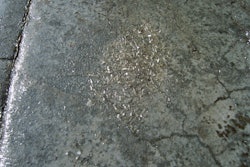Just as the California Building Standards Commission begins a mandated review of so-called "cool pavements," evidence continues to mount that highly reflective pavements aren't all they are cracked up to be.
The latest: a recent report from the National Center of Excellence for SMART Innovations at Arizona State University (ASU) outlines several negative consequences of relying upon reflective pavements as a mitigation strategy for the urban heat island effect (UHI). UHI, the phenomenon of higher temperatures in urban areas compared to surrounding rural areas, has gained notoriety in recent years and has led to a push for reflective roofing materials. A bill in the Legislature last year sought to extend the concept to pavements.
Despite perceived benefits, the ASU literature review finds growing evidence of substantial unintended consequences associated with widespread implementation of reflective pavements, including the potential for increased cooling loads in adjacent buildings; increased heating demands during cold weather; roadway snow and ice buildup during winter months; reduction in precipitation, runoff, and soil water content; and adverse human health impacts.
"Unfortunately, efforts to promote reflective pavements have moved more quickly than the scientific and engineering research," the report states. Click HERE to read the full report.
The new report comes on the heels of research by the University of California Pavement Research Center and the University of California, San Diego that also casts doubt on early pavement reflectivity claims. A bill signed into law last year by Gov. Jerry Brown, AB296, calls for the state Building Standards Commission to "consider" cool pavement concepts in the latest revision of state building codes. CalAPA, which opposed AB296, has transmitted the new ASU study findings to the state commission.
"As this report indicates, reflective pavements may cool a pavement's surface but there can also be negative environmental and social impacts on the areas adjacent to the pavement," said NAPA Director of Sustainable Engineering Dr. Heather Dylla. "Heat concentration in urban areas is a multifaceted problem; it requires a solution that looks at more than just one mitigation strategy."
To read Clean Air & Cool Cities, a position paper by NAPA on the issue, click HERE.




















